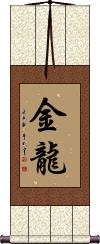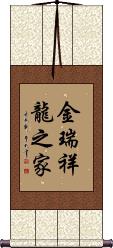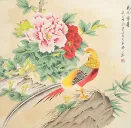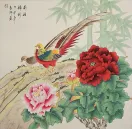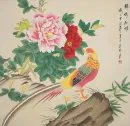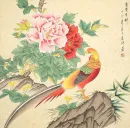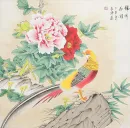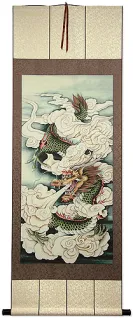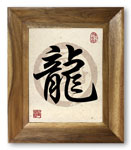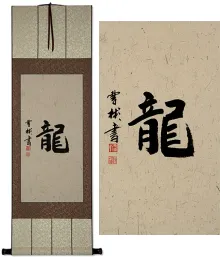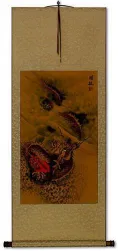Many custom options...
And formats...

Golden Dragon in Chinese / Japanese...
Buy a Golden Dragon calligraphy wall scroll here!
Personalize your custom “Golden Dragon” project by clicking the button next to your favorite “Golden Dragon” title below...
Golden Dragon
Golden/Metal Dragon
The Year of the Golden/Metal Dragon
金龍 is Golden/Metal Dragon in Chinese.
In the Chinese zodiac and sexagenary (60-year) cycle, this combination occurs in years that include 1880, 1940, 2000, and 2060.
In the sexagenary cycle, this year is represented by 庚辰.
See Also: Dragon
Home of the Auspicious Golden Dragon
This 金瑞祥龍之家 or “home golden auspicious dragon” title was added by special request of a customer.
The first character means gold or golden.
The second and third characters hold the meaning of auspiciousness and good luck.
The fourth character is dragon.
The fifth is a possessive modifier (like making “dragon” into “dragon's”).
The last character means home (but in some context can mean “family” - however, here it would generally be understood as “home”).
Note: The word order is different than the English title because of grammar differences between English and Chinese. This phrase sounds very natural in Chinese in this character order. If written in the English word order, it would sound very strange and lose its impact in Chinese.
Note: Korean pronunciation is included above, but this has not been reviewed by a Korean translator.
This in-stock artwork might be what you are looking for, and ships right away...
Gallery Price: $268.00
Your Price: $148.88
Gallery Price: $268.00
Your Price: $148.88
Gallery Price: $63.00
Your Price: $35.00
Gallery Price: $65.00
Your Price: $35.88
Gallery Price: $268.00
Your Price: $148.88
Gallery Price: $65.00
Your Price: $35.88
Gallery Price: $268.00
Your Price: $148.88
Chinese Golden/Red Butterfly & Flower Painting
Discounted Blemished
Gallery Price: $53.00
Your Price: $29.00
Not the results for Golden Dragon that you were looking for?
Below are some entries from our dictionary that may match your Golden Dragon search...
| Characters If shown, 2nd row is Simp. Chinese |
Pronunciation Romanization |
Simple Dictionary Definition |
金龍 see styles |
kinryuu / kinryu きんりゅう |
More info & calligraphy: Golden Dragon |
金竜 see styles |
kinryuu / kinryu きんりゅう |
golden dragon; (place-name) Kinryū |
Variations: |
kinryuu; kinryou / kinryu; kinryo きんりゅう; きんりょう |
golden dragon |
The following table may be helpful for those studying Chinese or Japanese...
| Title | Characters | Romaji (Romanized Japanese) | Various forms of Romanized Chinese | |
| Golden Dragon | 金龍 金龙 | kin ryuu / kinryuu / kin ryu | jīn lóng / jin1 long2 / jin long / jinlong | chin lung / chinlung |
| Golden/Metal Dragon | 金龍 金龙 | jīn lóng / jin1 long2 / jin long / jinlong | chin lung / chinlung | |
| Home of the Auspicious Golden Dragon | 金瑞祥龍之家 金瑞祥龙之家 | jīn ruì xiáng lóng zhī jiā jin1 rui4 xiang2 long2 zhi1 jia1 jin rui xiang long zhi jia jinruixianglongzhijia | chin jui hsiang lung chih chia | |
| In some entries above you will see that characters have different versions above and below a line. In these cases, the characters above the line are Traditional Chinese, while the ones below are Simplified Chinese. | ||||
Successful Chinese Character and Japanese Kanji calligraphy searches within the last few hours...
